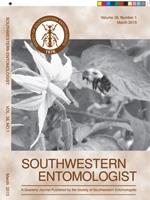Blastospores of lsaria fumosorosea Wize grown in a bioreactor with casaminoacids or collagen peptone as the nitrogen source were evaluated for effectiveness against nymphs of silverleaf whitefly, Bemisia argentifolii Bellows & Perring, in cotton, Gossypium hirsutum L. The I. fumosorosea blastospores produced in the two liquid culture media were formulated with and without diatomaceous earth and sprayed onto terminal leaves of cotton in the field. The effectiveness of the materials was compared with Specifik®, a commercial formulation containing 1 × 1011 conidia per gram of I. fumosorosea formulated with Rhudo®, and a mixture of insecticides (Endosulfan® Rescate® 20 PS). Blastospores produced in the medium containing casaminoacids as the main source of nitrogen and formulated with diatomaceous earth, as well as blastospores produced in the medium containing collagen peptone and not formulated with diatomaceous earth were most effective in reducing the number of nymphs. These experimental formulations killed 23–66% of the nymphs at 4 and 6 days posttreatment. Specifik® was less effective than the best experimental formulations and was effective only at 4 days post-application in the second experiment. The insecticides Endosulfan® plus Rescate® 20 PS used by some cotton growers were not effective on any sampling date.
How to translate text using browser tools
1 March 2013
Application of Isaria fumosorosea Blastospores Produced in Liquid Culture for Control of Bemisia argentifolii on Cotton Plants
M. G. Lozano-Contreras,
M. G. Maldonado-Blanco,
M. Elías-Santos,
A. González-Hernández,
U. Nava-Camberos
ACCESS THE FULL ARTICLE

Southwestern Entomologist
Vol. 38 • No. 1
March 2013
Vol. 38 • No. 1
March 2013




